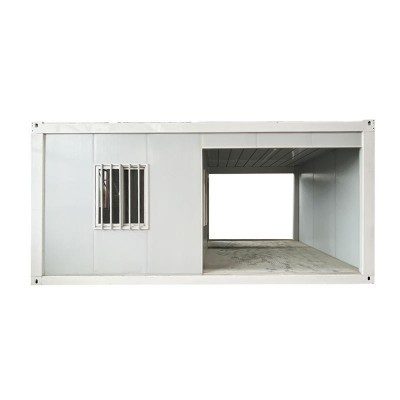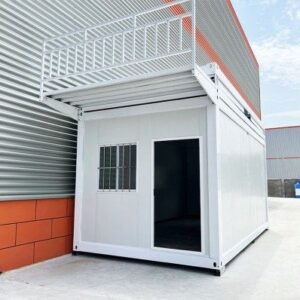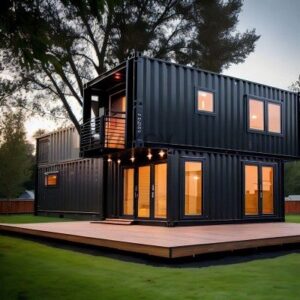Breaking Down the Cost of a Container House A Detailed Price Analysis
When figuring out the how much cost a container house, it helps to break down the expenses into clear categories. Here’s a detailed look at the main cost drivers:
Base Cost of Containers New vs Used
- New shipping containers usually cost between $3,000 and $6,000 each for a standard 20-foot unit.
- Used containers can be cheaper, often ranging from $1,500 to $3,000, but may require more repairs or modifications.
- Larger 40-foot containers generally cost about 1.5 to 2 times more than 20-foot versions.
- Choosing new vs used impacts your budget significantly at the start.
Design and Architectural Fees
- Hiring an architect or designer can add $2,000 to $10,000+ depending on project complexity.
- Custom container home designs or stacked/fused container layouts cost more than simple single-unit setups.
- Architectural fees cover plans, permits, and ensuring your build meets local codes.
Interior Finishing Flooring Walls Plumbing Electrical
- Interior setup varies widely based on quality, size, and customization:
- Flooring and walls: Basic finishes cost less, premium materials like hardwood or tile raise costs.
- Plumbing and electrical: Expect $10,000 to $25,000+ depending on installation complexity and fixtures.
- Efficient planning can keep these costs manageable while maintaining livability.
HVAC and Insulation Systems
- Proper insulation is key for comfort and energy efficiency—spray foam or panel insulation costs vary between $1,500 and $6,000+, depending on size.
- HVAC systems (mini-splits or central AC) typically add $3,000 to $8,000.
- This category affects long-term energy bills too, so investing here pays off over time.
Roofing and Exterior Treatment
- Modifying or upgrading container roofs and exterior finishing includes:
- Adding overhangs or sloped roofing to handle rain and sun.
- Exterior painting or cladding (wood, metal, etc.) to improve durability and appearance.
- Costs here range from $2,000 to $10,000+ depending on materials and design.
On-Site Costs Foundation Site Prep Landscaping
- Preparing the site includes foundation work (concrete pads, piers, or slabs), grading, and drainage solutions.
- Foundation and site preparation can cost $5,000 to $20,000+, influenced by soil conditions and local labor rates.
- Landscaping or exterior work is extra and can vary widely based on preferences and scope.
Typical Container House Price Ranges and Examples
When considering how much a container house costs, prices vary widely depending on size, complexity, and finishes. Let’s break down the typical ranges you’ll see in the U.S. market for container homes built with 1 to multiple containers.
Small Container Homes 1-2 Units
Small container homes usually involve one or two shipping containers, often 20 or 40 feet in length. These are ideal for tiny houses, studios, or simple guest rooms.
- Price range: $20,000 to $60,000
- Includes basic interior finishes, insulation, plumbing, and electrical
- Prefab kits can lower costs
- Example: A 20ft single container home can start around $25,000 with basic setup (20ft single container house)
- Shipping, foundation, and permit fees are in addition to base build costs
Medium Sized Container Houses 3-5 Units
Medium-sized container houses combine three to five containers to create functional homes with multiple rooms and amenities.
- Price range: $70,000 to $150,000+
- More customization options: full kitchen, bathrooms, multiple bedrooms
- Higher quality insulation, windows, doors, and finishes
- Often modular designs that allow flexible layouts
- Example: Combining multiple container units for a spacious family home can approach $120,000 depending on finishes (small container house options)
Large Custom Multi-Unit Container Homes with Luxury Finishes
For full-sized custom homes with luxury features, multiple containers are stacked, fused, and highly customized.
- Price range: $150,000 to $300,000+
- High-end interior finishes, advanced HVAC systems, smart home features
- Complex foundation work, landscaping, and architectural fees
- Large footprint homes, sometimes multi-story
- Real life examples show costs can reach $250,000 for 4,000+ sq ft designs with premium materials
Real Life Cost Summaries
| Home Size | Containers Used | Typical Cost Range | Key Features |
|---|---|---|---|
| Small | 1-2 | $20,000 – $60,000 | Basic utilities, compact design |
| Medium | 3-5 | $70,000 – $150,000 | Full amenities, moderate finishes |
| Large Custom | 6+ | $150,000 – $300,000+ | Luxury finishes, multi-story, large layouts |
These ranges give a solid idea of what you might expect when budgeting your container home project. For more detailed options, including prefabricated container homes, check out prefabricated container house options.
What Is a Container House Definition and Types
A container house is a residential structure built using steel shipping containers. These versatile units are repurposed to create affordable, customizable living spaces. Container homes range from a single container unit, ideal for tiny houses or small offices, to multiple containers that are stacked or fused together for larger, multi-room homes. The design possibilities include simple layouts with containers side by side, or complex modular configurations joined to maximize space and functionality.
Common types include:
- Single container homes: Compact and efficient, usually 20ft or 40ft containers converted into livable spaces
- Multiple containers stacked: Containers placed vertically or horizontally to create multi-story or wider floor plans
- Fused designs: Containers cut and welded together for open interiors with custom room layouts
Each type offers flexibility depending on space needs, budget, and site constraints.
Advantages of Container Housing Over Traditional Homes
Container homes boast several key advantages compared to conventional construction:
- Cost Efficiency: Using repurposed containers significantly reduces material costs and construction time.
- Speed of Construction: Container homes can be built and installed much faster than traditional houses, often in a matter of weeks.
- Sustainability: Repurposing old containers reduces waste and the overall carbon footprint of the build. Steel containers are durable and recyclable.
- Durability and Strength: Designed to handle heavy loads and harsh conditions, containers offer a structurally sound base for homes.
- Mobility and Modularity: Container homes can be disassembled and relocated or expanded by adding more units over time.
These advantages make container homes an attractive option for affordable, modern housing solutions tailored to the US market. Their combination of efficiency, sustainability, and flexibility addresses growing demand for alternative housing options.
Key Factors Influencing Container House Costs
When figuring out how much it costs to build a container house, several important factors come into play. Understanding these can help you budget better and avoid surprises.
Size and Number of Containers Used
The most obvious driver of cost is the size and number of containers. A single 20-foot container home will be cheaper than a multi-container structure. More containers mean higher material costs plus more complex construction, which raises labor and installation fees.
Location and Local Costs
Where you build directly impacts price. Local labor rates, availability of skilled workers, and permit fees differ by state and county. Shipping containers also need to be transported, so delivery costs vary depending on how far containers must travel to your site.
Customization and Finishes
How customized your container home is will heavily influence the budget. This includes options such as:
- Insulation quality (important for energy efficiency)
- Types and number of windows and doors
- Interior finishes like flooring, cabinetry, and fixtures
- Installation of utilities such as plumbing, electrical wiring, and HVAC systems
More upgrades and luxury finishes add up quickly, pushing the price higher.
Foundation and Site Preparation
Aside from the containers themselves, your site needs to be ready. This covers:
- Clearing and grading the land
- Pouring a foundation designed for container structures
- Installing drainage and basic landscaping
Site prep can be a surprisingly big part of your overall budget depending on the terrain and soil condition.
Delivery and Installation
Getting the containers delivered and set on-site requires equipment and labor. Crane or forklift rentals and skilled operators are necessary to place containers exactly where they belong. Installation involves welding and structural integration, adding time and expense.
Regulations Permits and Certifications
Building codes for container homes are evolving but still vary widely. Securing building permits, passing inspections, and meeting zoning rules can be costly and time-consuming. You may also need special certifications if your home uses off-grid systems or innovative designs.
Knowing these cost influencers helps you plan better for the container home budget. Keeping designs simple, choosing accessible locations, and working with experienced professionals can help control expenses.
For a detailed guide on building container houses and related costs, you can visit how to build a container house.
Comparing Container House Costs with Traditional Houses
When looking at container house costs versus traditional houses, there are clear differences that can affect your budget and timeline.
Cost Per Square Foot Comparisons
Container homes typically come in at a lower cost per square foot. While traditional homes in the U.S. average around $150 to $250 per square foot, container homes often range between $100 and $175 per square foot, depending on size, finishes, and location. This difference is mainly because shipping containers provide a ready-made structure, reducing framing and basic construction expenses.
Time to Build and Associated Savings
One of the biggest advantages of container homes is build speed. Traditional houses can take several months to over a year to complete. In contrast, container homes often take just a few weeks to a couple of months, thanks to the modular, prefabricated nature of containers and streamlined assembly. This faster timeline translates to savings on labor costs and allows homeowners to move in sooner, reducing temporary housing or rental expenses.
Long Term Maintenance and Energy Efficiency
Container homes also tend to have lower long-term maintenance costs if properly finished and maintained. Their steel shells resist pests and structural issues common in traditional wood-frame houses. When insulated well, container homes can be highly energy-efficient, keeping heating and cooling costs down. However, achieving this efficiency requires investing in good insulation, ventilation, and sometimes specialized HVAC systems upfront.
while the initial price tag for a container home can be more competitive, the real savings come from quicker construction and lower ongoing costs compared to a traditional house. This makes container living an attractive option for those looking to build smart and save over time.

Hidden and Ongoing Costs of a Container House Construction
When budgeting for a container house, initial construction costs are just part of the picture. There are several hidden and ongoing expenses that can add up and impact your overall investment. Being aware of these helps you avoid surprises and plan your container home finances better.
Utility Hookups and Upgrades
Connecting your container house to utilities can be more complicated than with a regular home. These costs include:
- Water and sewer hookups: Depending on your site location, hooking up to municipal water and sewer lines can be expensive due to distance or terrain.
- Electricity connections: Extending electric service or upgrading the grid can add to permit and installation fees.
- Internet and phone lines: Remote locations might require extra costs for reliable service.
- Off-grid systems: If you choose solar panels, septic tanks, or generators, factor in installation and maintenance expenses.
Maintenance Costs
Container homes, due to their unique materials and structure, have specific upkeep needs:
- Rust prevention and repairs: Steel containers need regular inspections for rust or corrosion, especially in humid or coastal areas.
- Sealing and weatherproofing: Maintaining insulation and sealing gaps to prevent leaks and drafts requires periodic attention.
- Painting and exterior care: To protect the steel, you may need to repaint or treat the exterior every few years.
- Pest control: Although generally pest-resistant, areas where containers meet or gaps are sealed can become entry points for insects.
Insurance Costs
Insuring a container house is sometimes more complex than standard homes:
- Homeowners insurance: Some insurers may charge higher premiums or require specialized policies because container homes are less common.
- Coverage for unique risks: Consider coverage for corrosion-related damages or off-grid system components.
- Replacement value: Insure based on actual rebuild costs including container purchase, customization, and installation—not just market value.
Financing and Loan Costs
Financing a container house can carry extra charges and requirements:
- Higher interest rates: Loans for container homes may have higher rates due to unconventional construction.
- Down payment requirements: Lenders often expect larger down payments compared to traditional home mortgages.
- Construction loans: If building from scratch, short-term construction loans might have fees and require detailed project plans.
- Appraisal challenges: Valuing container homes can be tricky, potentially complicating the loan approval process.
Understanding these hidden and ongoing expenses ensures your container home project stays within budget over the long term. Include them early in your shipping container home budget to avoid unexpected financial strain.
How to Budget for Your Container Home Project Cost Effectively
Budgeting for a container house project means planning ahead and being realistic about all the expenses involved. Here’s how to approach your container home construction cost and avoid surprises down the road.
Set a Realistic Budget Based on Project Scope
- Determine the size and design you want. Smaller homes with one or two containers are cheaper, while larger, customized multi-container homes cost more.
- Research local prices for containers, labor, and permits. Costs vary widely across regions in the US, so check quotes in your area.
- Include all major cost categories: container purchase, site prep, foundation, utilities, interior finishes, and installation.
Allocate Contingency Funds for Hidden Costs
- Set aside at least 10-15% of your total budget for unexpected expenses. Foundation issues, permit delays, or price changes in materials often pop up.
- Plan for ongoing costs like utility hookups, insurance, and maintenance to avoid financial strain after moving in.
Compare Professional Quotes versus DIY Approaches
- Getting detailed quotations from contractors and container home specialists helps clarify actual construction costs.
- DIY building can save money but requires time, skills, and permits. Account for your abilities and how much you can realistically take on.
- For complex systems like plumbing and electrical, hiring pros often saves money in the long run by avoiding costly mistakes.
Understand Financing Options for Container Homes
- Financing container homes can be tricky; they often don’t qualify for traditional mortgages.
- Explore options like personal loans, construction loans, or specialized lenders focused on alternative housing.
- Factor in loan interest, down payments, and terms in your budget to get the full picture.
Account for Local Market Conditions and Regulations
- Costs related to permits, inspections, and certifications vary by city and state.
- Some areas have stricter codes that could increase foundation or insulation expenses.
- Research your jurisdiction’s requirements early to adjust your budget accordingly.
By planning carefully and including all these factors in your container home budget, you’ll be better prepared financially and avoid surprises during your build.
Cost Saving Tips from Yichen Experts for Container House Construction
When looking to reduce the container house construction cost, following proven strategies can help you save money without compromising quality or comfort. Here are some practical tips from Yichen experts that work well in the U.S. market.
Choose Used Containers to Lower Base Costs
Buying used shipping containers instead of new ones can save you a substantial amount upfront. Used containers often cost 30-50% less than new ones, and many are still structurally sound for building.
- Inspect containers carefully for rust, holes, or damages before purchase
- Opt for local sellers to cut down on shipping fees
- Factor in minor repairs and repainting into your budget
Use Modular Designs to Simplify Construction
Modular, stacked or fused container designs minimize the complexity of construction, reducing labor costs and build time.
- Stick to simple shapes or fewer container units to avoid expensive custom welds
- Pre-planned modular kits are often cheaper and faster to assemble
- Modular designs also ease permit approvals and inspections
Leverage Local Materials and Labor
Using locally sourced materials and hiring local contractors can significantly cut costs, especially with rising transportation and labor expenses.
- Local insulation, drywall, and finishes usually cost less than imported alternatives
- Local labor familiar with regional building codes provides faster project turnaround
- Support for local trades often results in better customer service and quality control
Plan for Energy Efficiency Early to Save Long-Term Costs
Installing efficient insulation, windows, and HVAC systems from the start helps reduce energy bills and ongoing maintenance expenses.
- Invest in high-quality insulation suited for your region’s climate
- Use double-pane, energy-efficient windows to minimize heat transfer
- Consider solar panels or energy-saving appliances when budgeting
- Proper ventilation design can prevent costly moisture damage or mold
These cost-saving strategies not only make container house building more affordable but also increase the durability and livability of your home in the long run. By carefully choosing containers, design, materials, and energy solutions, you can build smarter for less.
Frequently Asked Questions About Container House Costs
How much does it cost to ship containers to different regions
Shipping a container varies widely based on location, container size, and shipping method. For the U.S., shipping a 20ft container typically costs between $1,000 and $4,000 domestically. International shipping, such as from overseas suppliers, can run much higher — around $2,000 to $6,000 or more depending on the distance and port fees. Always factor in additional costs like customs clearance and inland trucking, which can add several hundred dollars.
Can I add more containers later and how does that affect cost
Yes, you can add more containers later to expand your container home. However, this often involves:
- Additional design and engineering costs to ensure structural stability when stacking or joining containers.
- Extra foundation and site work to support the new layout.
- Increased permits and inspections fees depending on local regulations.
- Added expenses for utilities and finishes in the new container space.
Adding containers later is flexible but typically more expensive per container compared to including them all upfront due to these extra logistical and regulatory steps.
What permits are necessary in typical jurisdictions for container houses
Permits vary widely by city and county, but the basics usually include:
- Building permits to ensure your container home meets local building codes.
- Zoning approval confirming container homes are allowed in your chosen area.
- Electrical, plumbing, and mechanical permits for utility installations.
- Sometimes, special permits are required for shipping container structures since they differ from traditional builds.
It’s crucial to check with your local building department early in the process. Some places require signed engineering plans or inspections during different construction phases, which can also impact cost and timeline.
Ignore permits at your own risk—unauthorized construction can lead to fines or having to tear down parts of your build



